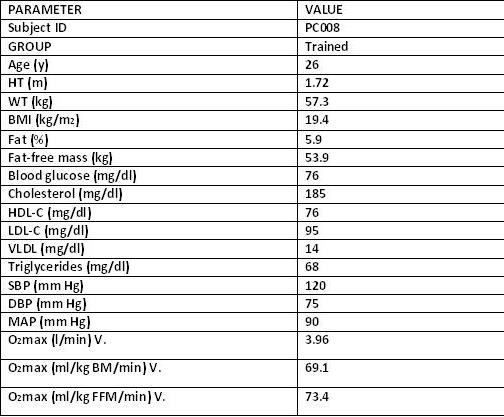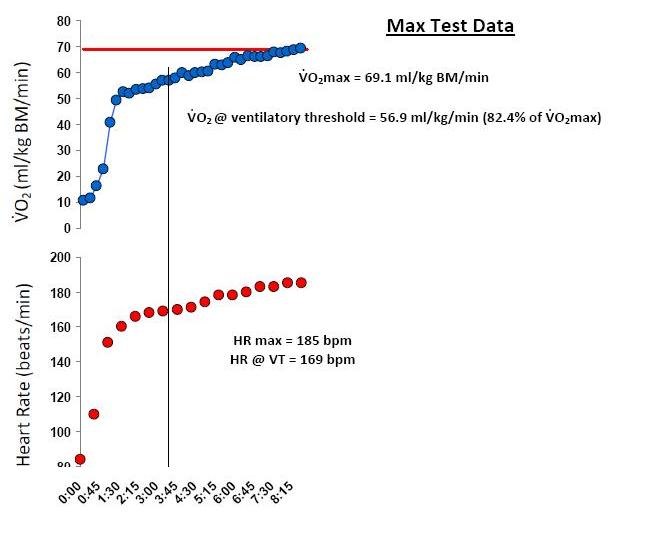VO2 max and ventilatory threshold are two terms that many runners want to know to help them improve performance. Unfortunately, they’re not the best metrics for determining your training or potential.
You’d be better off building your endurance with more volume (cross-training can help bridge the gap!) or by getting stronger.
I recently participated in an exercise study that included VO2 Max Testing and measured several key indicators for endurance, including my ventilatory threshold. The endurance testing I did wasn’t specifically geared for performance improvement (it was measuring progenitor cells in my blood before and after exercise), but I gathered a lot of valuable information.
My VO2 Max was measured on a treadmill using an incline test method. Every two minutes, the incline increased. It started at 0%, then went to 3%, 6%, and finally concluded 8% when the test concluded after 8:30 of running.
My VO2 Max result, 69.1 ml/kg/min, is pretty good and I’m pleased with it. But I’m surprised it’s so high because all of my race times predict a lower score. My mile PR of 4:33 predicts a VO2 Max of about 66 while my marathon PR of 2:44:38 predicts a VO2 Max of about 59.
Ultimately, VO2 Max is not a good predictor of race performance. Steve Magness, an accomplished runner, coach, and exercise physiologist, explains the “Fallacy of VO2 Max” in a great (but long) post. The conclusions that I draw from this article is that VO2 Max does not change in trained athletes and it doesn’t correlate with performance. So why try to improve it?
A more useful metric is lactate threshold – or the point at which lactate starts to increase dramatically in the blood. The LT can be improved upon in training through long runs, tempos, and an overall high volume program.
Unfortunately, I didn’t get my lactate threshold tested. But my ventilatory threshold was measured which is very similar. The VT is the point when respiration increases significantly due to the accumulation and exhalation of metabolic by-products.
VO2 Max and Ventilatory Threshold Testing
Below are several graphs that visually depict my results.



Researcher’s Analysis
“From top to bottom, these charts show your (i) oxygen uptake, (ii) heart rate, (iii) pulmonary ventilation (rate of air taken in & breathed out by the lungs), and (iv) respiratory exchange ratio during your max test. The x-axis (time in minutes) on the bottom panel corresponds with all four panels.
Your max VO2 was 69.1, which is considered very high and is typical of high-level endurance athletes. Healthy sedentary people your age may have values of ~45 ml/kg/min, whereas world class athletes (e.g. Olympic runners) may have higher values, e.g. high 70’s to more than 80 ml/kg/min, but only the tiniest minority of runners ever reach the level you’re at. You should be pleased with this result, as you are clearly a highly-trained athlete.
Your ventilatory threshold (VT) data are probably most useful for you. VT is closely associated with a metric you have probably heard of called the “lactate threshold”, and both are used as indicators of training status. Your VT is indicated by the vertical line crossing all panels. This occurred at 82% of your VO2 Max; the VT of some elite endurance athletes has been recorded at >90% of their VO2 Max.
Your heart rate of 169 beats/min at your VT could be used to guide your training. Essentially, you can train to increase endurance performance by regularly working at higher intensities (heart rates) than your threshold.
The data shown in the bottom two panels, pulmonary ventilation and respiratory exchange ratio are what I actually used to calculate your VT, so I include them here but they have little applicability to training and racing situations for you.”
Let’s Get Nerdy: Help Me Analyze!
This is admittedly a far more scientific, in-depth, and nerdy post than I normally do here at Strength Running. I would normally not post this, but I recently had a good discussion with a new runner who was trying to measure his VO2 Max so he could predict his future race results.
Like I mentioned, VO2 Max is not a good predictor of race performances. It doesn’t change in trained runners and can change little in moderately trained runners. So why train to improve it? Why even pay that much attention to it?
If any of you have a background in exercise physiology, have done any testing yourself, or just want to chime in, please do in the comments! Are there any actionable lessons I can take from this experience? What is the most valuable data here? How can I use this data to alter my training and improve as a runner?
If you’d rather have a private conversation, please email me at support@strengthrunning.com. I’d love to hear your thoughts. If we can learn a lot from this discussion, I’ll post a follow-up “lessons learned” article so we can all become better runners!
Please share this post with anybody that might be interested!
Recommended Reading:
- The oxygen cost of ventilation and its effect on the VO2 plateau: Interpreting VO2max
- Exercise Testing and Interpretation: A Practical Approach
- The Cutting-Edge Runner: How to Use the Latest Science and Technology to Run Longer, Stronger, and Faster